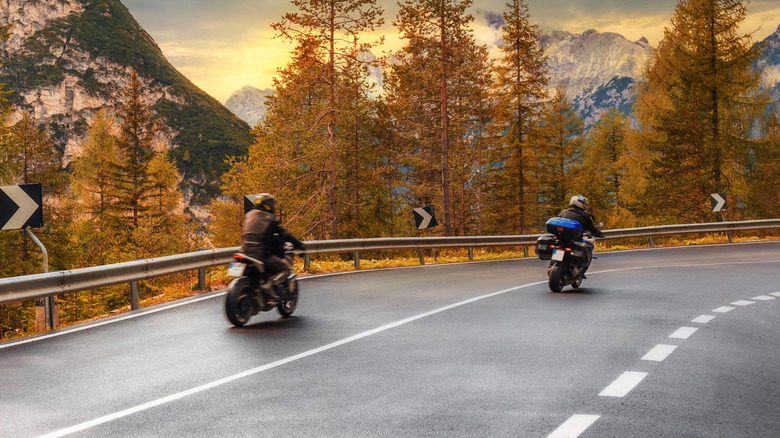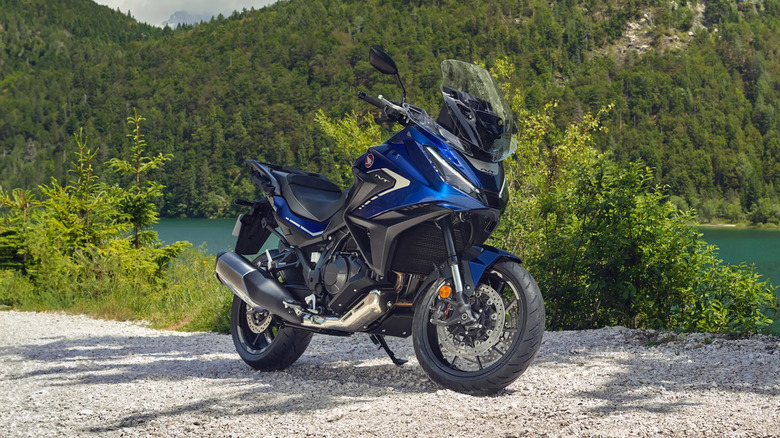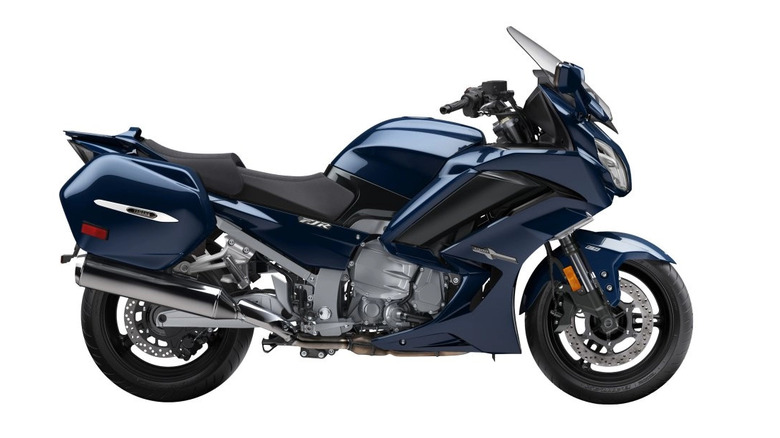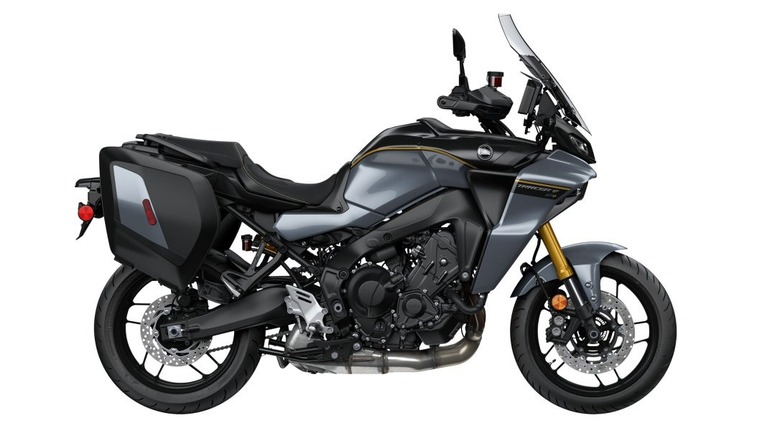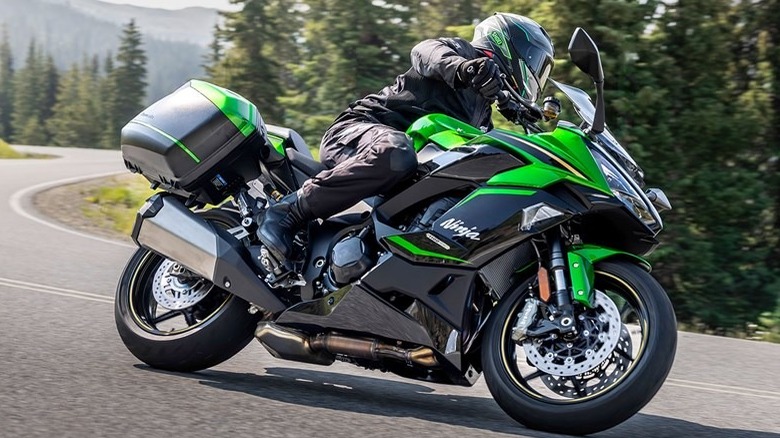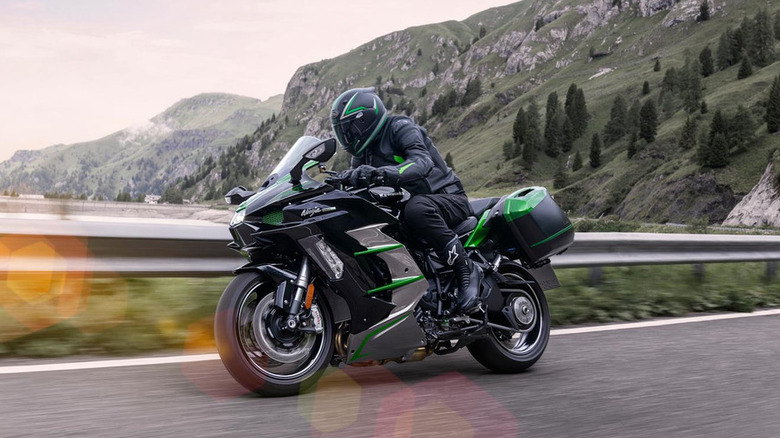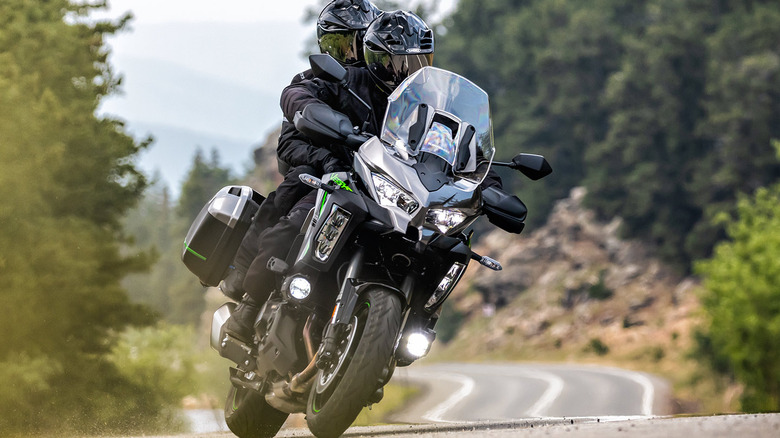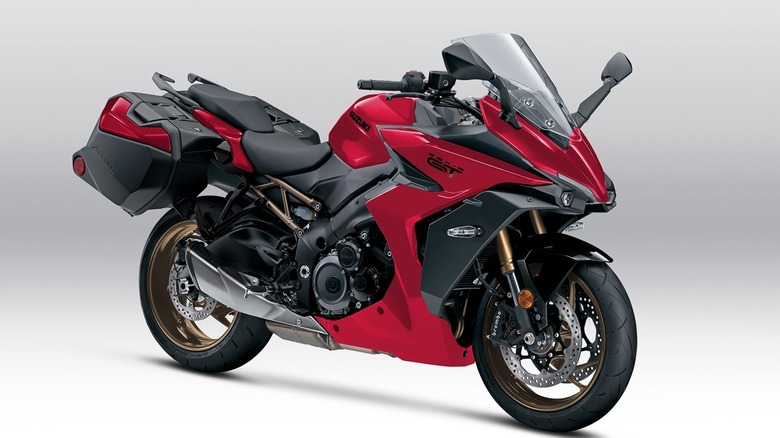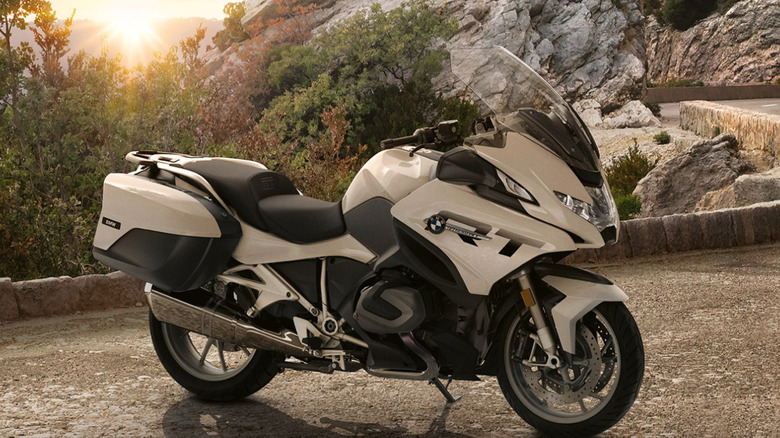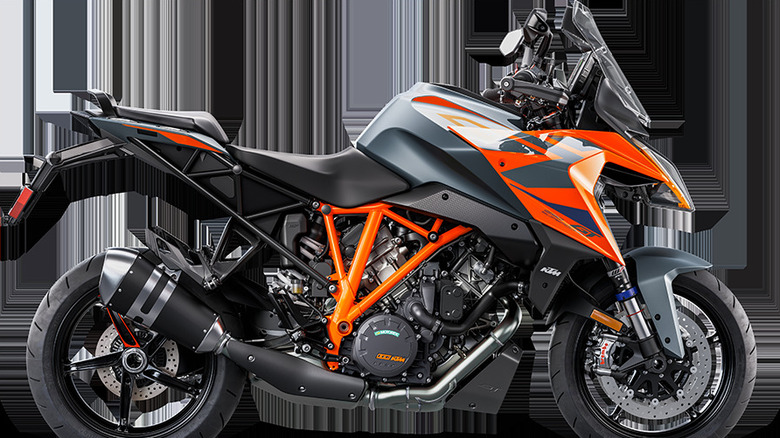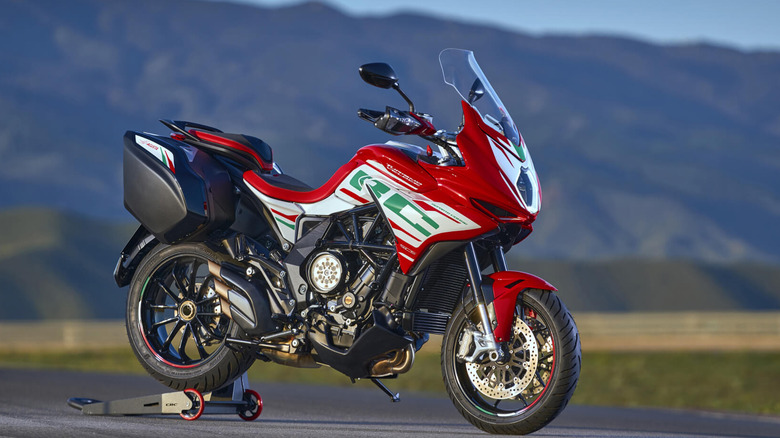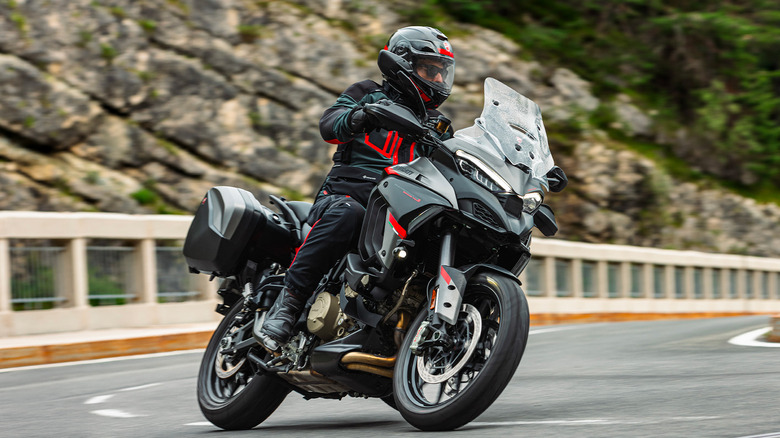Every Major Sport Touring Motorcycle On The Market Today
Supersport motorcycles like the Kawasaki Ninja or Yamaha R-Series offer a thrilling experience and incredible performance at the expense of comfort. These bikes might be the fastest around a track, but they make little concession to anything other than being blisteringly fast, sleek, and aerodynamic handling machines.
Lightweight seats with minimal padding, aggressive riding posture, a lack of luggage, and almost no recognition that a passenger might be onboard contribute to making supersport bikes super fun to ride but downright painful for extended journeys.
Fortunately, the market recognizes the need for thrilling capability in a package that won't numb your hands and twist your muscles into a pretzel. Sport-touring motorcycles represent the best of both worlds: pulse-pounding performance along with comfort and features that make extended riding not only tolerable but downright luxurious.
Sport-touring motorcycles come in different shapes and sizes. Some are geared toward adventure riding with high-ground clearances, while others are bonafide knee draggers that do everything possible to put the "sport" in sport-touring while remaining comfortable to ride.
Join us as we review the state of the sport-tourer, checking out the features, improvements, and additions to the latest from today's major manufacturers.
Honda NT1100
Despite an extensive line of just about everything, Honda's only nod to the sport-touring world for 2025 is the NT1100, and it's not available in the United States. Introduced in 2022, the NT1100 is based on Honda's popular Africa Twin adventure bike. The formula has struck a chord; in 2023, the NT 1100 was Europe's best-selling sport-tourer.
A 1,084cc parallel-twin engine delivers 100 hp and 82 lb-ft of torque in a package that weighs about 550 pounds. The 17-inch wheels encourage riders to keep the bike on the asphalt, and a 6.5 TFT multi-information display provides access to Apple Play and Android Audio.
Honda has added a six-axis inertial measuring unit (IMU) to the 2025 model. The unit tracks the bike's lean angle and feeds data to the traction control and ABS systems, giving the NT1100 sophistication lacking in previous models. Honda also added a Showa Electronically Equipped Ride Adjustment system, allowing riders to set the bike up as aggressively or forgivingly as they desire.
The riding position is upright, protected from the wind by a windscreen that kicks the worst up and over the rider's head. The seating offers 20% more space for the rider, while the luggage includes 73 liters of storage — up eight liters from last year's model. Urban trim buyers also get an additional 50-liter color-matched top case that doubles as a passenger backrest.
The NT1100 is a competent little bike, but if you really want it, you'll have to move to Europe.
Yamaha FJR1300 ES
The FJR 1300ES has been Yamaha's flagship sport-tourer since its debut in 2001 and has nearly a quarter-century of pedigree to rely upon. Equipped with a smooth and powerful 1,298cc double-overhead (DOHC) 16-valve liquid-cooled inline 4-cylinder, it leans toward the sport end of the sport-touring spectrum. No surprise, coming from the builder of some of the fastest Yamaha motorcycles ever made.
It's been a while since the FJR's last major overhaul in 2016, and it is yet to be seen if Yamaha will issue a 2025 model. For now, it remains one of the biggest bore and displacement sport-tourers. The bike makes 142 hp and 102 lb-ft of torque delivered through a smooth shaft drive via a snappy six-speed transmission with a tall sixth gear that cruises at 75 mph at 3,500 rpm.
Though nearly a decade has passed since its last generational renewal, the Yamaha retains a modest list of amenities, including traction control, selectable throttle modes, and an electronically adjustable suspension to help riders get as low as they want in the twisties.
Adjustable seating and handlebars allow riders up to 5 inches of movement. Thoughtful touches like heated grips, cruise and traction control systems, and integrated quick-release hard luggage aren't groundbreaking, but Yamaha has taken an if-it-ain't-broke-don't-fix-it approach.
The FJR 1300ES isn't cutting-edge, but it is plenty of understated fun. Its ultra-competent sports-touring package offers a balance of performance and enjoyment, making it a good pick for the supersport rider looking to graduate to sport-touring.
Yamaha Tracer 9GT+
The Tracer 9GT+ takes a significantly different approach from the FJR. In the Yammie lineup since 2018, the Tracer began as a 700cc parallel twin, similar to the R7, but received a quick promotion to the 890cc triple-cylinder CP3 Yamaha uses in the XSR900.
At first glance, the Tracer doesn't scream speed, but the truth is that the CP3 makes ample power. It has 117 hp at 10,000 rpm and 68.6 lb-ft of torque at 7,000 rpm, pushing a wet weight of 492 pounds. A KYB semi-active suspension marries comfort with performance, aided by an array of adjustable features and amenities.
The Tracer shares several gizmos with the FJR, including traction control with Sport, Street, Rain, Custom settings, and the six-axis IMU, but it also goes further. With a radar system the FJR lacks, the Tracer gets adaptive cruise control and a unique system that senses the proximity of nearby vehicles and adjusts braking bias for controlled stops.
Riders can adjust the handlebars up to 10mm, and the footpegs can move 14mm up and 4mm to the rear of standard settings. The Tracer's 10-level adjustable windscreen and heated handgrips keep riders out of the worst of the wind and cold, making it one of the best Yamaha motorcycles for long rides.
The Tracer is a different experience than the FJR. Still, it showcases Yamaha's willingness to welcome other types of riders to its sport-touring segment, even if Kawasaki has an even wider array of choices.
Kawasaki Ninja Series
There is a lot to unpack here. Ninja used to be a byword for pure supersport performance. However, in recent years, Kawasaki has liberalized the Ninja line to include everything from baby supersports to battery-powered e-bikes to sport-touring hyperbikes. Lately, Kawasaki has taken a throw-everything-at-the-wall-and-see-what-sticks approach to its sport-touring line, all to the consumer's benefit.
This year, a new Kawasaki motorcycle announced for 2025, the Ninja 1100 SX, serves as an upgrade from the 2024 Ninja 1000 SX. Despite the increase in displacement from 1,043 ccs to 1,099 ccs, the horsepower has surprisingly decreased from 140 hp to 134 hp. However, the longer stroke of the 1100 model results in better mid-range power and torque delivery, enhancing the bike's performance on the open road.
Kawasaki offers the 1100 in two variants — the standard SX and the SX SE. The primary difference is the additional $1,700 cost for the SX SE model, which adds Brembo front brakes and an Öhlins S46 gas-charged rear shock, enhancing the bike's overall performance for aggressive riders.
The Ninja SX models do not come with luggage, though some can be accessed through Kawasaki's accessories market. The Ninja 1100 takes big lessons from the nameplate's supersport legacy, evident in the sharp lines and aggressive posture of the 2025 model.
Kawasaki Ninja H2 SX & SE
Kawasaki developed the H2 from the ground up as the latest battle to determine who makes the fastest production motorcycle on the street. The H2 achieved its goal in Kawasaki's Ninja H2R, which is not street-legal in the U.S. It's a model that set new standards in speed and performance before Kawasaki promptly applied its new platform to sport touring editions.
The 998cc liquid-cooled in-line DOHC 4-cylinder sounds par for the course, but all that changes when you get to the heart of the matter: a supercharger custom-designed by Kawasaki Heavy Industries. The supercharger makes the H2 a tad heavier than typical supersports. The SX and SE weigh about 589 pounds and produce 195 hp against the H2R's 476 pounds and 305 hp.
The SE and SX are equipped with a slew of cutting-edge rider aids. Performance is enhanced by an IMU, launch control, engine brake control, cornering management, and an electronically controlled suspension.
Nods to their roles as tourers include a windshield with a less dramatic rake, improved ergonomics, and full fairings covering the trellis frame exposed on the H2R. Other features include collision warnings, adaptive cruise control, and a SPIN infotainment app.
Like the Ninja 1100 SX and SE, the H2 SE and SX are far more oriented toward being sportbikes than tourers. You can dress a hyperbike up with aftermarket luggage and a detuned engine, but it remains a hyperbike.
Kawasaki Versys
The Versys has been in Kawasaki's lineup since 2006 when it debuted the Versys 650 as a middleweight oddball blending elements of adventure, sport, and dual-sport riding. Since then, Kawasaki has refined and defined the Versys to arrive at three adventure-oriented sport-tourers: the X-300, Versys 650, and Versys 1100 SE LT.
The X-300 and 650 use parallel-twin engines, while the full-sized Versys 1100 SE LT gets the in-line four-cylinder treatment and all the touring rider aids found in the Ninja 1100 and H2 SX and SE. The Kawasaki Versys 1100 is new for 2025, bumped up from the 1000cc displacement of the previous year.
The Versys 1100 SE LT ABS is an upright, adventure-style bike for cruising highways and byways. It makes 133 hp at 9,000 rpm and 82.5 lb-ft of torque at 7,600 rpm. Multiple power modes, traction control, cruise control, anti-lock brakes, and quick-shifter technology help riders put that power to the ground any way they please.
The Versys 1100 includes a pair of 28-liter saddlebags as standard equipment – a nice change from the bagless Ninja 1100. While Kawasaki's other sport-touring bikes are aggressive performance machines, the Versys takes a more relaxing approach. Direct competitors with Honda's NT 1100 and Yamaha's Tracer 9, Kawasaki seeks to convince riders that it is the premier adventure sport touring motorcycle available.
Suzuki GSX-S1000GT & GSX-S1000GX
Suzuki is the final member of the big four Japanese manufacturers on the list, chiming in with its GSX-S1000GT and GSX-S1000GX sport touring bikes.
While all of the big four manufacturers offer powerful sport-tourers, Suzuki stands out with its liter-class GSX-S1000GX, a sport-oriented touring bike similar to Kawasaki's Ninja 1100 SX. Fully faired and powerful, the S1000GT delivers 150 hp and 80 lb-ft of torque at 9,500 rpm. It also includes the proprietary Suzuki Advance Electronic Suspension, drive mode selection, traction control, and a fully adjustable KYB fork.
The GSX-S1000GX is a recent addition to the Suzuki lineup. It showed up in 2024 as an adventure-style sport-touring bike that Suzuki classifies as a crossover. With a suspension stroke 30 mm higher in the front and 20 mm in the rear, it's not meant to hug the pavement like the S1000GT. It doesn't qualify as a dual-sport, but the GX is better equipped to handle poorly maintained roads that may be a tad off the beaten path.
Suzuki has adopted a strategy of covering two major sport-touring niches (sport and adventure) based on the same architecture. Sharing an engine and several ride-control features, they nonetheless differ in mission. Which one you prefer is a matter of how you like to ride.
BMW R1250 RT
Though Japanese bikes make up a considerable part of the market, there are plenty of offerings from other parts of the world, not the least of which is the BMW R 1250 RT. BMW foregoes classifying its bikes as sport-touring hybrids, preferring to separate sport from touring altogether. Nonetheless, the 2024 R1250 RT has a foot in both worlds.
BMW is a premium brand, and that is reflected in the R 1250 RT's features and price tag. The base MSRP starts at $19,995, and fully loaded models can reach up to the $30,000 range. Either way, riders enjoy a 1,254 cc two-cylinder boxer engine attached to a six-speed transmission with a wet clutch. The upshot is 136 hp and 105 lb-ft of torque in a motorcycle with a low center of gravity and smooth power delivery. It's no lightweight at 615 pounds, but that may be why BMW prefers to keep it classified in its touring lineup.
Adventure-style sport-touring motorcycles may be unsuitable for shorter riders due to their seat height. BMW separates itself from the adventure crew with a relatively low seat height of 31.7 inches. Hard side cases and Road, Rain, and Eco driving mode selections come standard. The usual suspects of propriety traction management systems are present, but the Beemer stands out with a massive 10.25-inch TFT display.
The R 1250 RT costs a pretty penny. Some of that is undoubtedly a brand name tax, but BMW's best offers impressive finish and sophistication.
KTM 1290 Super Duke GT
Respected bike builder KTM has entered the sport-touring game with a bike that, like the H2, heavily skews toward sport riding. The KTM 1290 Super Duke GT is an absolute rocket. An LC8 V-twin genuinely nastifies this wicked bike, making 175 hp and 104 lb-ft of torque. With a 460-pound wet weight, we're talking superbike-level power.
The Super Duke employs an unconventional design style, including stalk-like rearview mirrors and a razor-sharp quarter fairing that exposes the trellis frame. The result is somewhat alien, though it clearly communicates aggressive capability, even if it splits opinions on whether it is beautiful or ugly.
One of the notable things about KTM motorcycles is their focus on maintaining a relaxed riding experience with an upright seating position and an easy-to-read 7-inch TFT display that relays navigational and performance information at a glance. Adaptive cruise control, heated grips, adjustable windscreen, and a collection of rider aids are KTM's justification for classing this beast as a sport-tourer. However, luggage only comes as an add-on.
The 1290 Super Duke GT treats touring as an afterthought, but it could be the right bike for someone who wants a performance machine during the week while retaining the ability to slap some bags on for a weekend trip.
MV Augusta Turismo Veloce
With such a beautiful country, it should be no surprise that Italian MV Augusta got into the sport-touring game with the Turismo Veloce. With distinctive styling with an exotic Italian flair, the Turismo Veloce may be the most radical-looking bike on this list.
MV Augusta sticks close to its roots in developing avant-garde motorcycle designs wrapped around powerful and interesting engines. The Turismo comes in three variations, all powered by a 4-stroke, 12-valve triple cylinder making 110 hp out of 798 cubic centimeters. Weighing 438 pounds, it is positively a featherweight machine.
The bottom of the line starts with the R, which MV Augusta classifies as "an easy tourer." Next up, the Lusso SCS purports to combine travel with style, while the top dog RC SCS claims to be the raciest of the three.
Like the KTM Super Duke GT, the Turismo Veloce focuses primarily on performance. MV Augusta purists and fans who won't ride anything else can be happy that the Italian bike builder has put something on the market to accommodate luggage for weekend adventuring.
Ducati Multistrada V4S Grand Tour
MV Augusta isn't the only fashionable Italian motorcycle producer to get in the sport-touring game. Ducati, known for motorcycles that are as beautiful to look at as they are to ride, puts forth the Multistrada V4S Grand Tour for your sport-touring consideration.
The Multistrada has been a part of Ducati's lineup since its unveiling for the 2002 model year. Two decades later, Ducati continues to develop the nameplate. Ducati offers the Multistrada in five variations, with the V4 Rally most closely resembling a sport-touring motorcycle.
Visually, the V4 Rally appears split between road prowess and off-road capability. Ducati insists it is as capable at long-range road riding as it is off the beaten path. As the name suggests, the Multistrada gets its 170 hp and 89 lb-feet of torque from a 90-degree V4 engine.
The V4 Rally comes in three trims: Radar, Adventure Travel & Radar, and Full Adventure. The Radar package provides bike buyers with radar technology to assist with its adaptive cruise control. Adventure Travel secures the radar package plus heated handgrips and hard luggage, and the Full Adventure is the whole package plus an Akrapovič silencer and carbon mudguard.
With its purported hybrid capability, this is a tall bike. The seat height is adjustable between 33.1 and 33.9 inches. Short riders might struggle to wrestle the 505-pound wet weight over uneven terrain.
The Multistrada is clearly a capable sport-touring bike with an adventuring twist.
